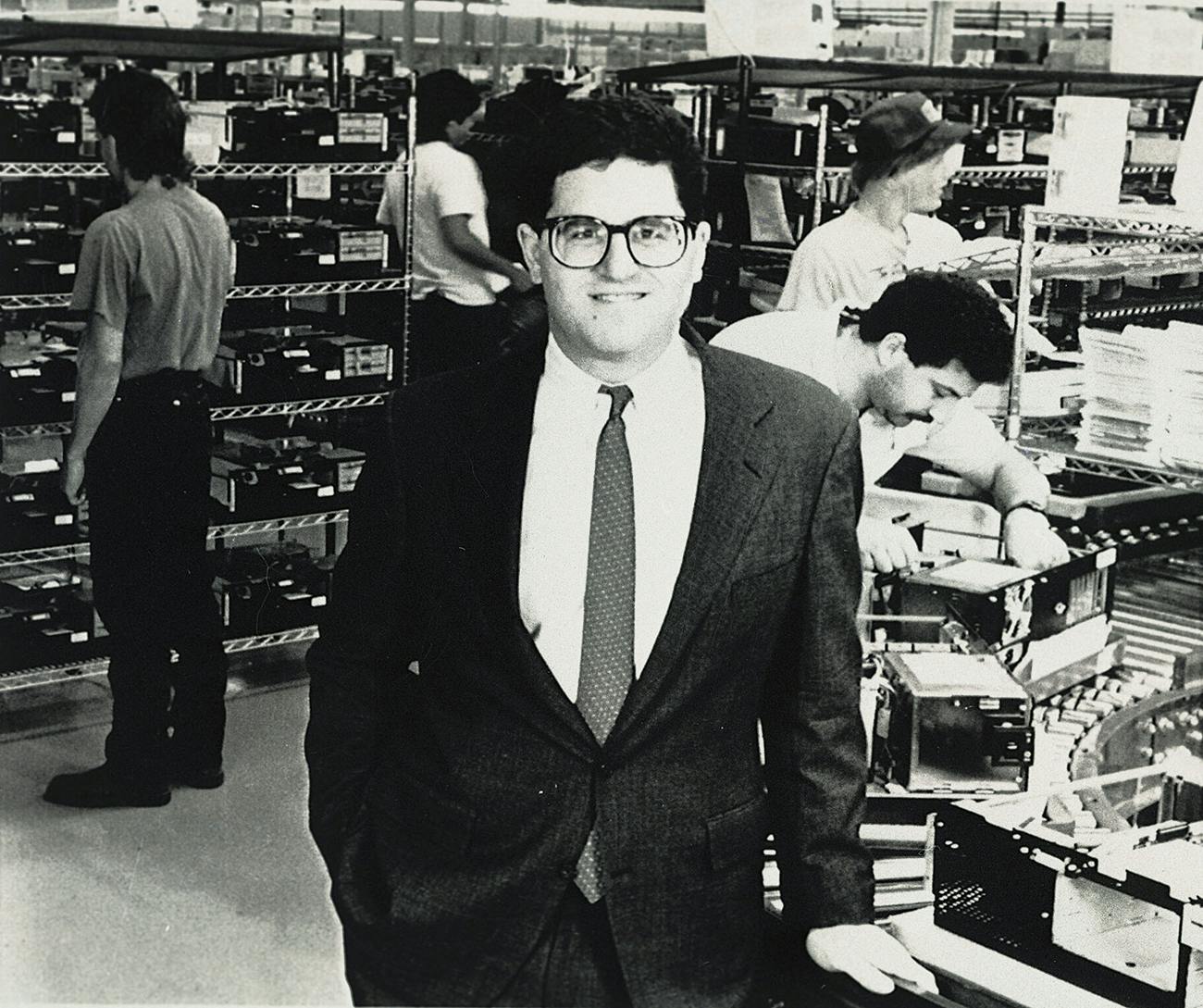Three decades ago, Michael Dell reinvented the way people bought personal computers. Back in the day, buying a PC was like buying a car: you went to a dealer and shopped the models in stock, which came with a handful of options. You bought the machine that best fit your needs, even if it wasn’t a perfect fit, and you paid a high price for it.
Dell, working out of his freshman dorm at the University of Texas at Austin in the mid-eighties, had a better idea. He offered customers a chance to pick only the options they wanted, then had the machine built to their specifications and sold it at a lower price because he didn’t have the overhead of retail stores and inventory. The result became the stuff of tech industry legend. By 2000, Dell’s Round Rock–based company was selling more than $35 million of computer equipment a day over the internet. It dominated the tech industry even after its two biggest rivals, Compaq and Hewlett-Packard, merged, in 2002. For most of the nineties, it was the best-performing stock on the Nasdaq exchange.
Seventeen years later, Michael Dell is looking to pull off another transformation: turning his company, which has struggled in recent years, into a fleet-footed organization that’s less focused on hardware than on managing business clients’ data needs. It’s not the kind of thing that makes someone a household name or lends itself to catchy marketing slogans like “Dude, you’re getting a Dell!” But it may be his last, best shot at returning his company to its former stature.
To trace the roots of Dell’s problems, you’ve got to go back to 2013, when its fortunes were sinking. It was still heavily wedded to PCs even though customers were shifting to smartphones and tablets, which Dell hadn’t had much success with. At the same time, Dell was struggling to adapt to the emerging business model of selling servers and data storage systems bundled with the software and consulting expertise that made it all work. Instead, the company remained mired in the hardware market, where the margins were razor thin and shrinking. Since Dell was a publicly traded entity, investors had come to expect growing sales, steady profits, and a rising stock price every quarter, none of which it could deliver.
Michael Dell needed to refocus his business. To do that, he had to back away from the PC market. But that would require some heavy spending on the front end and some quarterly losses in the short term, the sort of thing the stock market has little tolerance for.
Dell hoped that if he could free himself from quarterly earnings demands, he would be able to shift the company’s focus toward helping businesses set up and run their internal information systems. These business services come with long-term contracts, which create more predictable revenue, shielding the company from the ups and downs of the PC market. Other PC makers had tried similar strategies and failed. (In fact, Dell itself had tried to make such a move, buying Ross Perot’s Perot Systems for $3.9 billion in 2009. But that attempt hadn’t added up to much; Dell remained a marginal player in the field.)
As a private company, Michael Dell argued, Dell would have the elbow room to succeed where rivals such as Compaq and Gateway had flopped. Most analysts agreed that if Dell were going to undertake such a change, it needed to do so without the scrutiny and reporting requirements of the public markets.

In 2013 Michael Dell and Silver Lake Partners, a California private equity firm, took the company private in a $25 billion deal and quickly began to reinvent Dell away from the public eye. In 2016 he paid $67 billion for the Massachusetts-based enterprise technology firm EMC—which was almost twice Dell’s size—in the biggest tech acquisition ever. The transaction created what may be the world’s largest company that specializes in selling technology to businesses and then running it for them. To reflect its new direction, Dell Inc. changed its name to Dell Technologies, which made sense. The old Dell wasn’t really a technology company; it was a manufacturing wonder that spent far less on research and development than most of its rivals. In 2000, for example, its R&D spending was just $482 million, a third of what its biggest competitor, Compaq, spent. The new Dell is all about the tech. Between August and November of last year alone, the company spent more than $1 billion on R&D.
Analysts, most of whom were cautiously optimistic about the EMC deal at the outset, have been encouraged by the progress Dell has made in integrating the two companies. Sales for the fiscal year that ended February 1 were on track to top $90 billion, compared with $57 billion six years ago.
On December 28 the retooled company, its fortunes looking brighter than many had imagined possible, returned to the public markets, trading under the old DELL symbol on the New York Stock Exchange. Given his success after going private—and given that he will now have to host regular meetings with Wall Street analysts, who will scrutinize corporate results—why would Dell go public again? There was, first of all, the symbolic value of the move. “The public is enamored with companies that are public,” said Patrick Moorhead, the founder of Moor Insights & Strategy, an Austin-based technology research firm. “They power our 401(k)s, and they get captured on the news” in a way that private companies don’t.
And then there were the details of the financing of Dell’s 2013 privatization. Private equity firms often make investments with a five-year horizon; Silver Lake was ready to get some of its money back by taking the company public again. Michael Dell and Silver Lake made at least $12 billion on the deal.
It also surely didn’t escape anyone’s notice that the equity market is much hotter than it was when Dell went private; the Standard & Poor’s 500 Index has risen more than 40 percent during the past six years. That could work to Dell’s advantage, because having stock that’s rising in value could help it make future acquisitions without adding to its almost $49 billion in debt. Though the market is currently experiencing upheaval, the timing of the company’s return looks good.
The big question, of course, is whether Michael Dell can repeat his past success. To answer that, it helps to understand the new business he’s trying to dominate. Dell still sells PCs and other hardware (in fact, its PC sales have been rising the past couple of years), but now it often sells those machines as part of a bigger package that helps companies manage their servers, storage, networking switches, and the software behind it all. Michael Dell has said that his customers have “one throat to choke” when something goes wrong.
“Customers are looking for simplification,” said Moorhead, who believes the company is now well positioned in the market for business computing.
Dell is also betting on the hybrid cloud, the latest iteration of cloud computing. Because of the recent spate of data security breaches, companies have grown less willing to store all of their sensitive data on someone else’s servers. Many are now keeping some of their data in-house while sending less important material to the cloud. Thanks to the EMC acquisition, Dell can manage both of those tasks.
Finally, Dell hopes to become a major player in “edge” computing. Today, an increasing number of devices, from power-plant turbines to refrigerators, are connected to the internet. But the more connected things are, the more demands are put on them. Until recently, it was too expensive to put enough computing power on a forklift or a self-driving SUV to make real-time decisions. So data was sent out via the internet to a remote server, which then responded as quickly as it could. In certain situations, though, that wasn’t quick enough. An offshore oil rig, for example, may need to compute data on well pressure quickly, to determine if there’s a danger of a blowout. The time it took to send that data to shore, crunch it in a server, and send it back cost valuable seconds that could have made a difference in an emergency.
But as technology has continued to grow cheaper and more portable, it’s become possible to embed enough computing power in these devices that information can be accessed in real time at remote locations. If a dog darts in front of a self-driving car, for instance, onboard edge computers can react quickly, rather than waiting for a response to be formulated on a remote server and sent back to the vehicle.
Today, some 14 billion devices are connected to the internet. It’s been estimated that by 2031 that number will increase to 200 billion as the cost of building intelligent devices declines and their ability to store more data increases. “Using that information, especially in real time, provides better insight to build a better world,” Michael Dell said in 2016. “That is the challenge of our generation.”
Dell’s new investors are waiting to see if Dell can meet that challenge. Transitions are difficult for large companies, and Dell has undergone a wholesale makeover. While it’s still early, analysts point to some positive signs. Dell’s shares began trading at $46, and JPMorgan analyst Paul Coster advised investors to hold on to the stock until it hits $60—a significant indication of confidence. The new Dell, he said, will profit from being “one of the largest, most comprehensive, most integrated product and service companies” on the market. And while the company reported a loss in its latest quarter, it blamed that on the ongoing expenses of integrating EMC.
Dell still faces significant challenges, like competition from industry stalwarts such as IBM, which years ago sold its PC operations to focus on the higher-profit business of custom servers, software, and consulting. IBM has been very successful in that sector, but after the EMC acquisition, Dell is a major player too, with more than half a million customers. There’s also the question of whether the sort of one-stop shopping that Dell is pursuing works better than smaller, more specialized companies that provide services individually. Hew-lett-Packard split its PC and server operations into separate companies in 2015, seeking a smaller-is-better approach. The company claims that the move has allowed it to react more quickly to changes in the market, but Dell believes it can be big and still be nimble enough to respond to customers’ needs.
Dell’s comeback arrives on the cusp of what may be a new Austin tech boom, fueled not just by start-ups but by veteran outfits like Google, which has reportedly leased an entire 35-story building downtown, and Apple, which in December said it would invest $1 billion into expanding its presence in Austin, adding as many as 15,000 jobs. (That would make it Austin’s biggest employer, just ahead of H-E-B and Dell.) A resurgent Dell could once again transform Austin, just as the first wave of Dellionaires created numerous civic institutions throughout the city.
Dell’s greatest asset remains Michael Dell himself. In his company’s early days he was smart enough to recognize what he didn’t understand about the business and brought in seasoned executives like longtime Motorola executive Mort Topfer and Bain executive Kevin Rollins to guide him. Now, at 54, he’s got the experience to lead the latest transition himself. “It’s more his company now than it was before,” said Roger Kay, the founder of the market research firm Endpoint Technologies. “It’s not quite the Ferrari that Steve Jobs built for himself at Apple, but it’s still his machine.” Investors and employees alike are hoping Michael Dell has some gas left in the tank.
This article originally appeared in the March 2019 issue of Texas Monthly. Subscribe today.
- More About:
- Business
- Michael Dell
- Round Rock








